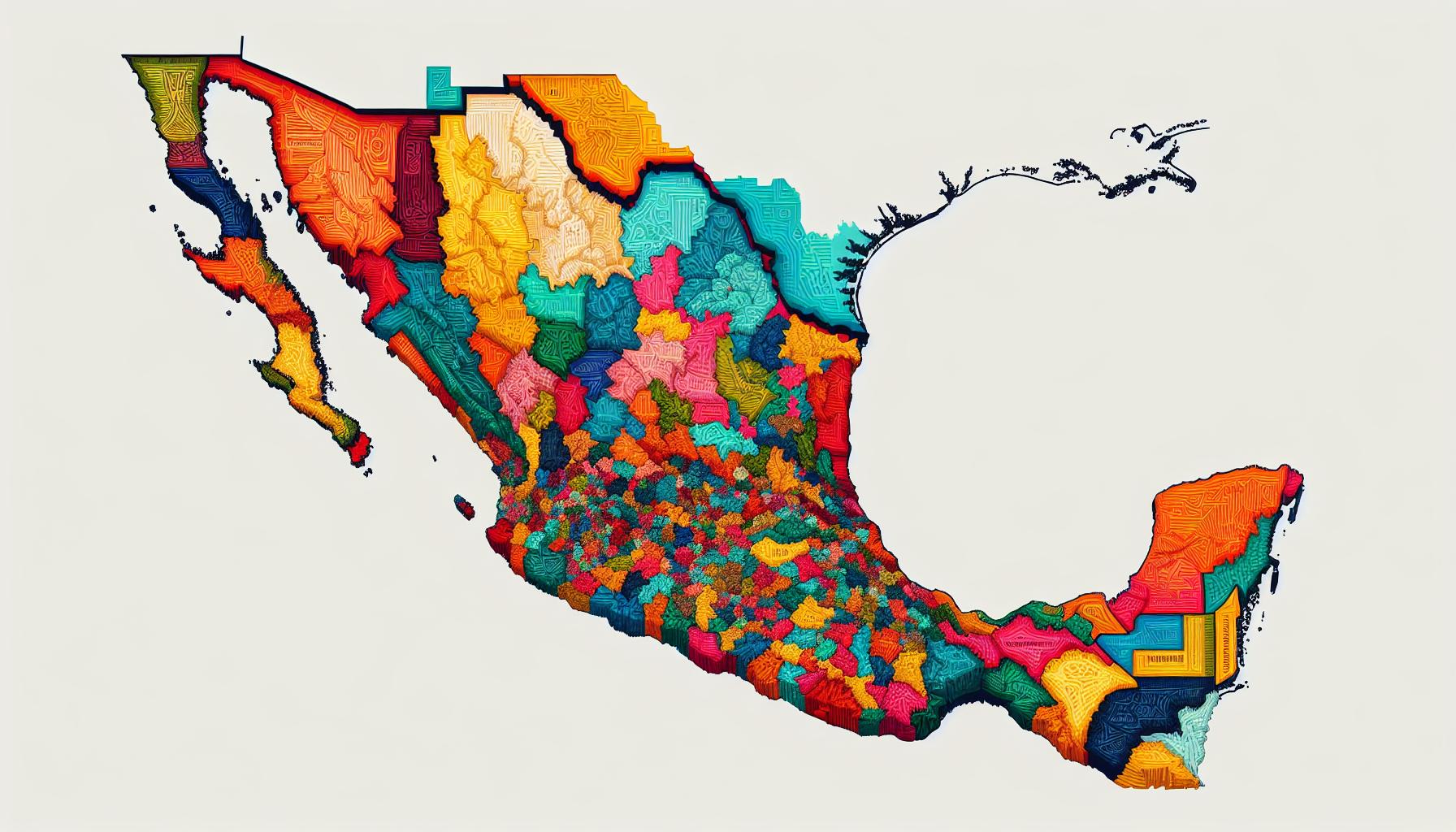Mexico’s rich tapestry of states forms a vibrant mosaic that tells the story of this diverse nation. From the sun-drenched beaches of Quintana Roo to the desert landscapes of Chihuahua, each of Mexico’s 32 states brings its own unique flavor to the country’s cultural feast.
Understanding Mexico’s political geography isn’t just about memorizing boundaries – it’s about discovering how these distinct regions shape the nation’s identity. The Mexican map reveals a fascinating puzzle of states, each contributing its own traditions, cuisine, and historical legacy to create one of Latin America’s most dynamic countries.
Estados:Oyyi5975pv8= Mapa De Mexico
Mexico contains 31 states and 1 federal district, creating a diverse political landscape across 761,610 square miles of territory. Each state operates under its own constitution while maintaining alignment with federal laws.
The states vary significantly in size and population:
| State Category | Number of States | Population Range |
|---|---|---|
| Large States | 8 | > 5 million |
| Medium States | 12 | 2-5 million |
| Small States | 11 | < 2 million |
Notable regions include:
- The Northern Border States: Baja California, Sonora, Chihuahua, Coahuila, Nuevo León, Tamaulipas
- The Central Highlands: Guanajuato, Querétaro, San Luis Potosí, Zacatecas
- The Pacific Coast: Jalisco, Guerrero, Oaxaca, Michoacán
- The Gulf Region: Veracruz, Tabasco, Campeche, Yucatán
Mexico City stands as a unique federal entity, serving as both the capital and the country’s political center. The city gained state-like powers in 2016 through constitutional reforms.
Each state maintains distinct administrative characteristics:
- Independent executive branches led by elected governors
- State legislatures creating local laws
- State judicial systems handling regional cases
- Municipal governments managing local affairs
- Manufacturing hubs in Nuevo León Querétaro
- Agricultural centers in Sinaloa Michoacán
- Tourism destinations in Quintana Roo Baja California Sur
- Oil production in Campeche Tabasco
Key Regions of Mexico

Mexico’s territorial organization divides into distinct geographical regions, each characterized by unique economic activities cultural heritage ecological features.
Northern Border States
The Northern Border States encompass Baja California Norte Sonora Chihuahua Coahuila Nuevo León Tamaulipas. These states share a 1,954-mile border with the United States creating a dynamic economic corridor. Manufacturing industrial parks maquiladoras dominate the economic landscape generating 45% of Mexico’s industrial output. The region’s arid climate features the Chihuahuan Sonoran deserts supporting specialized agriculture mining operations.
Central Mexican States
Central Mexico comprises Mexico City Puebla Querétaro Guanajuato Jalisco Estado de México. This heartland region serves as Mexico’s economic cultural nucleus housing 40% of the national population. The area’s volcanic soil supports extensive agriculture producing corn wheat vegetables. Major industrial centers in Guadalajara Querétaro contribute 35% of the country’s GDP through automotive electronics manufacturing sectors.
Southern States and Regions
The southern region includes Chiapas Oaxaca Yucatán Quintana Roo Campeche. This area preserves Mexico’s indigenous heritage with 60% of the population maintaining traditional languages customs. Tropical rainforests Mayan archaeological sites characterize the landscape. Tourism drives the local economy particularly in the Riviera Maya generating $23 billion annually. Agricultural exports include coffee cacao tropical fruits supporting rural communities.
Geographic Features Across Mexican States

Mexico’s topographical diversity spans across mountainous terrains, expansive plateaus coastal plains creating distinct ecological zones throughout its 32 states.
Mountain Ranges and Highlands
The Sierra Madre mountain system dominates Mexico’s landscape with three major ranges. The Sierra Madre Oriental stretches 1,000 kilometers along the eastern coast from Coahuila to Veracruz. The Sierra Madre Occidental extends 1,500 kilometers through the western states from Sonora to Jalisco. The Sierra Madre del Sur runs along the Pacific coast through Michoacán, Guerrero, and Oaxaca. The Mexican Plateau, elevated between 1,000-2,000 meters, connects the eastern and western ranges across central Mexico. Notable volcanic peaks include Pico de Orizaba (5,636 meters), Popocatépetl (5,426 meters), and Iztaccíhuatl (5,230 meters) in the Trans-Mexican Volcanic Belt crossing central Mexico.
Coastal Areas and Lowlands
Mexico’s coastline extends 9,330 kilometers, with the Pacific Coast spanning 7,338 kilometers through states like Baja California and Oaxaca. The Gulf Coast covers 2,805 kilometers from Tamaulipas through Veracruz to Yucatán. The Yucatán Peninsula features extensive limestone plains with cenotes throughout Quintana Roo, Yucatán, and Campeche. Coastal lagoons dot the Pacific shoreline, including Laguna de Términos in Campeche and Laguna Madre in Tamaulipas. Tropical lowlands characterize the southern states of Tabasco and Chiapas, with elevations below 200 meters supporting diverse ecosystems. The Balsas Depression creates a significant lowland region through Guerrero and Michoacán.
Political Organization of Mexican States

Mexico’s political structure operates under a federal system with 31 states and one federal entity. Each state maintains autonomous governance while adhering to federal regulations established by the Mexican Constitution.
State Governments and Capitals
Each Mexican state operates with three distinct branches of government: executive, legislative and judicial. The state executive branch features a governor elected for a 6-year term without reelection possibilities. State capitals serve as administrative centers, housing government offices, legislative assemblies and supreme courts. Notable capitals include Monterrey in Nuevo León, Guadalajara in Jalisco and Mérida in Yucatán. The state governments manage local affairs including education, infrastructure development and public safety within their jurisdictions.
Population Distribution
Mexico’s population concentrates in specific regions, creating demographic patterns across states. The central region, including Mexico City and the State of Mexico, holds 40% of the national population. Here’s the population distribution by region:
| Region | Population Percentage | Major Urban Centers |
|---|---|---|
| Central | 40% | Mexico City, Puebla |
| North | 25% | Monterrey, Ciudad Juárez |
| West | 20% | Guadalajara, León |
| South | 15% | Mérida, Cancún |
Dense urban areas characterize the central plateau states while northern states maintain lower population densities. The coastal states exhibit moderate population concentrations in major port cities.
Notable States and Their Characteristics
Mexico’s diverse states showcase unique economic strengths cultural heritage that contribute to the nation’s identity. Each state maintains distinct characteristics that shape its role in Mexico’s development.
Economic Centers
Mexico City stands as the primary economic hub, generating 17% of Mexico’s GDP through financial services technology sectors. Nuevo León emerges as a manufacturing powerhouse, with Monterrey hosting major industrial complexes that produce automobiles electronics aerospace components. The State of Mexico contributes 9.1% of national GDP through diverse industries including textiles chemicals pharmaceuticals. Jalisco drives technology innovation with its Silicon Valley-like corridor in Guadalajara, housing operations for IBM Intel Oracle. Veracruz powers maritime commerce through its ports, handling 35% of Mexico’s international trade.
| State | GDP Contribution | Primary Industries |
|---|---|---|
| Mexico City | 17% | Finance, Technology |
| State of Mexico | 9.1% | Manufacturing, Chemicals |
| Nuevo León | 7.8% | Automotive, Aerospace |
| Jalisco | 6.9% | Technology, Agriculture |
| Veracruz | 4.7% | Maritime Trade, Oil |
Cultural Heritage
Oaxaca preserves indigenous traditions through its 16 recognized ethnic groups crafts culinary practices. Michoacán embodies Mexican folklore with its Day of the Dead celebrations artisanal copper work butterfly sanctuaries. Yucatán maintains Maya heritage via archaeological sites like Chichen Itza traditional healing practices regional cuisine. Puebla combines colonial Spanish architecture with indigenous influences, evident in its Talavera pottery baroque churches historic buildings. Guanajuato reflects Mexico’s mining history through its silver-era architecture underground tunnels cultural festivals including the International Cervantino Festival.
Tapestry of Cultural Diversity
Mexico’s 32 states form an intricate tapestry of cultural diversity economic strength and political autonomy. Each state contributes uniquely to Mexico’s identity through its distinct governance structure regional traditions and economic specializations.
From the bustling industrial centers of the north to the rich cultural heritage of the south Mexico’s political geography reflects a nation that has successfully balanced unity with regional diversity. The country’s state system demonstrates how local autonomy and federal coordination can work together to create a dynamic and resilient nation.
Through this complex network of states Mexico continues to evolve while preserving its rich heritage and fostering economic growth across its varied landscapes.



